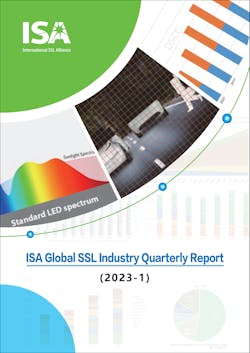Lingering economic impacts of the global COVID-19 pandemic, the ongoing Russia/Ukraine conflict, and the “limited success” of the 2022 United Nations Climate Change Conference (COP27) to combat global warming have all contributed to a slowdown in the global development and adoption of solid-state lighting (SSL), according to a recent report from the International Solid-State Lighting Alliance (ISA). To turn things around, the report states, the SSL industry should recommit to its long-standing focus on energy savings.
The goal of the ISA Global SSL Industry Quarterly Report is to share comprehensive data about the state of the industry, filling the information void that has occurred as other organizations, including the U.S. Department of Energy, have ceased publishing similar data, said Norman Bardsley, PhD, ISA chief analyst and the report’s editor. More specifically, this quarter’s report indicates that SSL companies should double down on their efforts to save more energy and spur greater LED adoption, he says.
“There’s a very common message from LED companies and LED analysts that the first phase of LED development is over — the phase that focused on energy savings and other environmental impacts — and the important thing now is to move over and think about the quality of lighting,” Bardsley explained. “While I don’t dispute that’s important, I really do think that recent events have shown us that we haven’t gone as far as we can in terms of what I see as the major goal, and that’s global impact.”
Impact of global events
The report summarizes how some of the most significant global events of the past few years continue to affect the SSL industry, with preliminary 2022 data indicating that LED sales are stalling. For instance, the report notes that COVID-19 pandemic-induced supply chain issues and worker shortages have limited LED device and lighting product advancement. It also explains how the broad response to the war in Ukraine has resulted in a substantial interruption in oil and gas exports from Russia. With these traditional energy sources constrained and costs high, the LED industry has an opportunity to regain traction as “motivation to replace traditional forms of lighting have been strengthened,” the report states.
Another event that has illuminated the need for greater energy savings is COP27. According to the report, the climate change conference, which included 190 countries, did little to move the needle toward combatting global warming. In fact, the report indicates that while the goal has been to keep average global temperatures from rising more than 1.5°C, some sources, including Climate Action Tracker, show that current national commitments are likely to lead to an average increase of 2.4° Celsius. It also notes that the COP27 failed to produce an agreement to reduce the use of fossil fuels. “Fossil fuels will continue to be used in electricity production for several more decades and are a major contributor to global warming and air pollution,” Bardsley said.
Although the introduction of SSL in the early 2000s resulted in significant energy savings, the report shows that the positive environmental impact was limited because global electricity consumption for lighting rose as demand for artificial lighting increased. Between 2015 and 2018 alone, demand for artificial lighting grew from 135 petalumen hours (Plmh) produced by 2,650 terawatt hours of electricity to 220 Plmh produced by 2,900 TWh, the report says. “Lighting contributes about 15% of global demand for electricity,” Bardsley explained. “Most of the increased demand comes from developing economies,” where artificial lighting use grows as populations and living standards increase.
Areas of opportunity
One opportunity for energy savings — and LED sales — is streetlighting. According to the ISA report, Samsung Semiconductors presented data at the LED Professional Symposium showing that global LED streetlight installation reached about 32 million units at a cost of approximately $3.5 billion in 2022. Although lower than pre-pandemic 2019 projections, data shows that LED streetlight market growth has slowly resumed. The report also states that if Samsung’s projections are correct, more than 80% of streetlights worldwide will be replaced with LEDs by 2027.
Fluorescent bans represent another opportunity for SSL to significantly impact the environment, Bardsley observed. Besides being less efficient than LEDs, fluorescent tubes contain mercury, a known toxin. Global policy makers as well as regional authorities have been working on timelines for phasing out mercury-containing lighting products. For instance, Vermont and California have introduced regulations that would ban linear fluorescent tube sales — the most popular fluorescent form factor — beginning in 2024. However, fluorescents require a different voltage and driver than LEDs, which poses a challenge in terms of compatibility with existing lighting and power distribution systems. But Bardsley contends that with further advancement, LEDs can supplant fluorescents. “There’s been talk about…getting rid of fluorescents for at least 10 years; it’s time we got serious about it,” he said.
Energy efficiency is also driving LED sales in the automotive industry. According to the ISA report, data from 12 market research companies shows that the size of the automotive lighting market ranges from $20 billion to $35 billion, with growth rates predicted between 3.2% and 9.5%. It’s unclear how much market share LED suppliers have captured (somewhere between $6 billion and $20 billion), but they are competing aggressively in the market, the report states.
“The main impact is headlights,” Bardsley said. “For electric vehicles, lower energy consumption can be used to increase the range between recharges or to reduce the weight of the batteries. Lighting and interior displays are often cited as design features” which can also be more efficiently executed with LED technology.
A priority adjustment
The global challenges of recent years show that the lighting community has an opportunity to reduce energy consumption while advancing the benefits of SSL, the report states. In Brazil, Russia, India, China, and South Africa in particular, data shows that lighting remains the most fruitful area for energy savings because it’s relatively easy to implement and has a measurable impact. “LED prices have come down substantially and the return on investment is rapid, even without government subsidies,” Bardsley said. He added, “for countries with severe energy shortages, there is less pain in saving electricity through LED adoption than almost all alternatives.”
With so much potential, Bardsley implores lighting manufacturers to make energy savings their top priority again. “I feel very, very strongly that the [lighting] industry should not downplay the role it can play in saving energy and other environmental impacts,” he said. “There is scope for substantial further increases in efficiency.”
JENNY JONES is an award-winning freelance writer based in Northern Virginia. She has more than 20 years of editorial experience and specializes in making complex subjects clear and engaging.
Follow our LinkedIn page for our latest news updates, contributed articles, and commentary, and our Facebook page for events announcements and more. You can also find us on Twitter.








